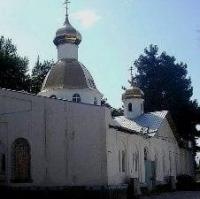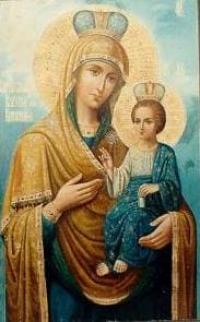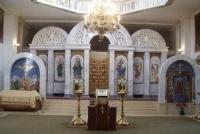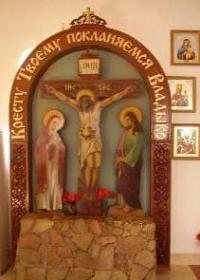Вы здесь
St. Nicholas Cathedral in Dushanbe.




Tours in Dushanbe.
"Knowledge of people's culture is not a guarantee of their cultural behavior"
Konstantin Kushner.
St. Nicholas Cathedral in Dushanbe.
St. Nicholas Cathedral is located on Druzhby Narodov Street, 58, southwest of the city cemetery in the eastern part of Dushanbe. St. Nicholas Cathedral is the cathedral church of the Dushanbe and Tajikistan diocese of the Russian Orthodox Church.
The main throne is consecrated in honor of St. Nicholas, the right throne - in honor of the righteous John the Russian, the confessor, the left - in honor of the icon of the Mother of God "Life-Giving Spring". The foundation of the cathedral was made at the end of 1943 and became possible due to a certain mitigation that took place in the USSR in relation to the Patriarchal Church that year.
Hard times for the Orthodox in Tajikistan came after the collapse of the USSR, when poverty and civil war forced a large number of Orthodox families to leave the country. In the spring of 2005, a major reconstruction of the entire building (the first in the years of its existence) began at St. Nicholas Cathedral, which continued until 2011.
The roof was re-roofed, new gilded domes were installed, floors were laid, new windows were installed, the altar of the main temple was rebuilt, and interior decoration was carried out. A bell tower was also erected at the facade of the cathedral, a redevelopment of the park territory was made, in which pavilions and benches were installed, new paths were laid.
The cathedral was decorated with sculptural images of the Virgin and the Savior. In place of the main walls separating the three aisles, graceful arched openings were built, uniting the temple area into one room. A marble iconostasis appeared in the main nave, forming three arcades filled with snow-white ganch carvings.
In addition to painted icons, mosaic icons appeared, made of natural semi-precious stones, placed on the iconostasis of the main nave: images of Christ, the Virgin, the Archangels Michael and Gabriel, the Apostle Peter and St. Nicholas.
The lapis lazuli frame of the temple icons of St. Nicholas and the Crucifixion of Christ was made from the mosaic. The lapis lazuli frame of the temple icons of St. Nicholas and the Crucifixion of Christ was made from the mosaic.
The back wall of the altar of the main nave is decorated with a mosaic panel "The Last Supper". A new kliros was built. A new iconostasis was also installed in the aisle of John the Russian. The wooden iconostases installed in both aisles were made by the wood carving master Alisher Bobodzhanov, who studied this art of Bukhara cabinetmakers.
His hands also made the throne in the Mother of God chapel and two icon cases of the main nave: for the icon of Xenia of St. Petersburg and the Three Hierarchs. In place of the main walls separating the three chapels, graceful arched openings arose, uniting the area of temple into one room.
The interior decoration of the temple was completely transformed, to which the best artists and specialists of the Bunedi Musaviriy Tojikiston CJSC (former Art Workshops) were involved. A marble iconostasis appeared in the main nave, forming three arcades filled with snow-white ganch carvings.
If earlier there were only hand-painted icons in the temple, now there are also mosaic icons made of natural semi-precious stones, placed on the iconostasis of the main nave: images of Christ, the Mother of God, the Archangels Michael and Gabriel, the Apostle Peter and St. Nicholas.
Also, the lapis lazuli frame of the temple icons of St. Nicholas and the Crucifixion of Christ was made from the mosaic. The back wall of the rebuilt altar of the main nave was decorated with a mosaic panel "The Last Supper".
The temple was decorated with mosaic icons. Master Safar Ahmedov worked on them. For two summer seasons, together with their teacher Leon Gurdjieff, they made a large mosaic panel on the facade of this temple, depicting the procession of the Lord to Golgotha (Way of the Cross).
The idea of the artist Akhmedov is to create icons in the style of Byzantine mosaics, that is, using natural and artificial stones (smalt). A new large icon of the Intercession of the Mother of God appeared on the eastern vault, commissioned specifically for St. Nicholas Cathedral, with the image of St. Nicholas on the right hand and St. John the Russian on the left side.
On other parts of the vault, the images of the Archangels Michael and Gabriel are written. At the end of the composition, elegant gilded ligature adorns the walls of the dome. A new iconostasis was also installed in the aisle of John the Russian.
The wooden iconostases installed in both aisles were made by the wood carving master Alisher Bobodzhanov, who studied this art of Bukhara cabinetmakers. His hands also made the throne in the Mother of God chapel and two icon cases of the main nave: for the icon of Xenia of St. Petersburg and the Three Hierarchs.
Portrait painters Svetlana Sharauskas and Sirojiddin Arabov renovated the icons installed in the iconostasis and walls of the chapel of John the Russian. Another craftsman, Timur Karavaev, made original furniture adapted to the specifics of the temple, music stands for choristers and other necessary things.
Next to the cathedral is the Central City Cemetery, which is popularly called the "Russian cemetery". Operates since 1937. Its territory is 160 hectares of land. People of various nationalities are buried in this cemetery: Russians, Jews, Armenians, Tajiks, Uzbeks and many others.
From the entrance, in the forefront of the cemetery, famous figures of the republic are buried: ministers, academicians, poets.
Geographic coordinates of St. Nicholas Cathedral in Dushanbe: N38°33'59 E68°49'00
Authority:
Valentina Kasymbekova. 25.05. 2011







